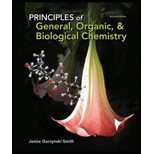
(a)
Interpretation:
The
Concept introduction;
Atomic number (Z):
Atomic number of an element is the number of protons or the number of electrons found in the nucleus of every atom of that element.
Mass number (A):
Mass number of an element is defined as the total number of protons and neutrons in an atom.
Protons:
A proton is one of three main particles that make up the atom. Protons are a tiny, dense region at the center of the atom. Protons have a positive electrical charge of
Neutrons:
Atoms of all elements except for most atoms of hydrogen have neutrons in their nucleus. Unlike protons and electrons, which are electrically charged, neutrons have no charge they are electrically neutral.
Electrons:
Electrons have an electric charge of
(a)
Explanation of Solution
Given,
The element symbol is
The mass number is
The atomic number of carbon is
Thus, the number of protons in the atom is
Thus, the number of electrons in the atom is
The number of neutrons can be calculated as,
The number of neutrons in an atom is
(b)
Interpretation:
The element symbol, atomic number, number of protons and the number of neutrons for the given mass number 35 and the number of electrons 15 has to be calculated.
Concept Introduction:
Refer to part (a).
(b)
Explanation of Solution
Given,
The number of electrons is
The mass number is
The atomic number of carbon is
Thus, the number of protons in the atom is
The number of neutrons can be calculated as,
The number of neutrons in an atom is
An element with atomic number
(c)
Interpretation:
The element symbol, atomic number, number of protons and the mass number for the given number of neutrons 35 and the number of electrons 30 has to be calculated.
Concept Introduction:
Refer to part (a).
(c)
Explanation of Solution
Given,
The number of electrons is
The number of neutrons is
The atomic number of carbon is
Thus, the number of protons in the atom is
The mass number can be calculated as,
The mass number is
An element with atomic number
(d)
Interpretation:
The atomic number, number of protons, number of neutrons, and number of electrons of Magnesium has to be given.
Concept introduction;
Refer to part (a).
(d)
Explanation of Solution
Given,
The element symbol is
The mass number is
The atomic number of magnesium is
Thus, the number of protons in the atom is
Thus, the number of electrons in the atom is
The number of neutrons can be calculated as,
The number of neutrons in an atom is
Want to see more full solutions like this?
Chapter 2 Solutions
Principles of General Organic & Biological Chemistry
- You may have noticed that when water boils, you can see bubbles that rise to die surface of the water. Which of die following is inside these bubbles? Explain. a. air b. hydrogen and oxygen gas c. oxygen gas d. water vapor e. carbon dioxide gasarrow_forwardArgon has three naturally occurring isotopes: 0.3336% 36Ar, 0.063% 38Ar, and 99.60% 40Ar. Estimate the average atomic mass of argon. If the masses of the isotopes are 35.968 u, 37.963 u, and 39.962 u, respectively, calculate the average atomic mass of natural argon.arrow_forwardGive three examples of gaseous elements that exist as diatomic molecules. Give three examples of gaseous elements that exist as monatomic species.arrow_forward
 World of Chemistry, 3rd editionChemistryISBN:9781133109655Author:Steven S. Zumdahl, Susan L. Zumdahl, Donald J. DeCostePublisher:Brooks / Cole / Cengage Learning
World of Chemistry, 3rd editionChemistryISBN:9781133109655Author:Steven S. Zumdahl, Susan L. Zumdahl, Donald J. DeCostePublisher:Brooks / Cole / Cengage Learning Chemistry for Engineering StudentsChemistryISBN:9781337398909Author:Lawrence S. Brown, Tom HolmePublisher:Cengage Learning
Chemistry for Engineering StudentsChemistryISBN:9781337398909Author:Lawrence S. Brown, Tom HolmePublisher:Cengage Learning Introductory Chemistry: An Active Learning Approa...ChemistryISBN:9781305079250Author:Mark S. Cracolice, Ed PetersPublisher:Cengage Learning
Introductory Chemistry: An Active Learning Approa...ChemistryISBN:9781305079250Author:Mark S. Cracolice, Ed PetersPublisher:Cengage Learning Chemistry: Principles and ReactionsChemistryISBN:9781305079373Author:William L. Masterton, Cecile N. HurleyPublisher:Cengage Learning
Chemistry: Principles and ReactionsChemistryISBN:9781305079373Author:William L. Masterton, Cecile N. HurleyPublisher:Cengage Learning Chemistry & Chemical ReactivityChemistryISBN:9781133949640Author:John C. Kotz, Paul M. Treichel, John Townsend, David TreichelPublisher:Cengage Learning
Chemistry & Chemical ReactivityChemistryISBN:9781133949640Author:John C. Kotz, Paul M. Treichel, John Townsend, David TreichelPublisher:Cengage Learning Chemistry & Chemical ReactivityChemistryISBN:9781337399074Author:John C. Kotz, Paul M. Treichel, John Townsend, David TreichelPublisher:Cengage Learning
Chemistry & Chemical ReactivityChemistryISBN:9781337399074Author:John C. Kotz, Paul M. Treichel, John Townsend, David TreichelPublisher:Cengage Learning





